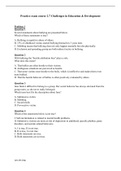Tentamen (uitwerkingen)
Practice Exam course 2.7 Challenges in Education and Development
- Instelling
- Erasmus Universiteit Rotterdam (EUR)
Consists of 80 questions: 10 per problem and 10 for the lectures. Most answers are given with a clear explanation. Is very representative for the exam.
[Meer zien]




